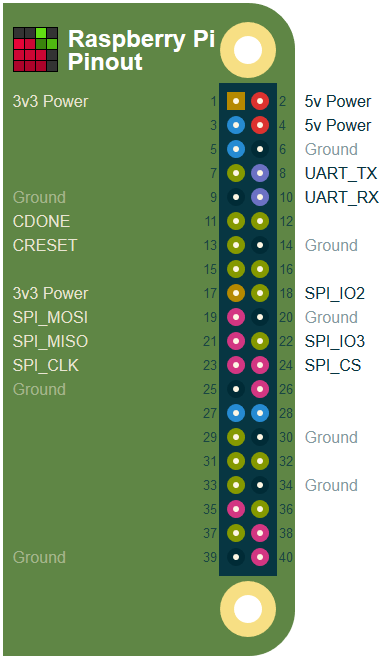The EVT version of Fomu is a "stretch" PCB with a Raspberry Pi header. Additionally, the factory test jig for production versions of Fomu has pins that match up with a test jig with the same pinout.
These tools can be used to control an FPGA and its accompanying SPI flash chip.
To build this repository, simply run make.
The EVT boards can be attached directly to the Raspberry Pi as a "hat". When building a test jig, attach wires according to the following image:
The only pins that are required are 5V, GND, CRESET, SPI_MOSI, SPI_MISO, SPI_CLK, and SPI_CS.
The Pi's hardware SPI interface must be enabled in the kernel- use
raspi-config or add dtparam=spi=on to /boot/config.txt and reboot before
using. You can improve performance by attaching SPI_IO2 and SPI_IO3 and running
fomu-flash in quad/qpi mode by specifying -t 4 or -t q.
You can get serial interaction by connecting the UART pins, but they are not necessary for flashing.
The most basic usecase is to load a program into configuration RAM. This is a very quick process, and can be used for rapid prototyping.
To load top.bin, use the -f argument:
# ./fomu-flash -f top.binThis will reset the FPGA, reset the SPI flash, load the bitstream into the FPGA, and then start running the program.
To write a binary file to SPI flash, use -w:
# ./fomu-flash -w top.bin # Write top.bin to SPI Flash
# ./fomu-flash -r # Reset the FPGAThis will erase just enough of the SPI to hold the new binary file, then flash the binary to SPI.
It will not reset the FPGA. To do that, you must re-run with -r.
You can verify the SPI flash was programmed with the -v command:
# ./tomu-flash -v top.binYou can "peek" at 256 bytes of SPI with -p [offset]. This can be used to quickly verify that something was written.
fomu-flash supports patching ROM. To do this, you must synthesize your bitstream with a fixed random ROM contents. This is so fomu-flash has something to look for.
The Python code for this would look like:
def xorshift32(x):
x = x ^ (x << 13) & 0xffffffff
x = x ^ (x >> 17) & 0xffffffff
x = x ^ (x << 5) & 0xffffffff
return x & 0xffffffff
def get_rand(x):
out = 0
for i in range(32):
x = xorshift32(x)
if (x & 1) == 1:
out = out | (1 << i)
return out & 0xffffffff
def get_bit(x):
return (256 * (x & 7)) + (x >> 3)And the corresponding C code looks like:
uint32_t xorshift32(uint32_t x)
{
/* Algorithm "xor" from p. 4 of Marsaglia, "Xorshift RNGs" */
x = x ^ (x << 13);
x = x ^ (x >> 17);
x = x ^ (x << 5);
return x;
}
uint32_t get_rand(uint32_t x) {
uint32_t out = 0;
int i;
for (i = 0; i < 32; i++) {
x = xorshift32(x);
if ((x & 1) == 1)
out = out | (1 << i);
}
return out;
}
static uint32_t fill_rand(uint32_t *bfr, int count) {
int i;
uint32_t last = 1;
for (i = 0; i < count / 4; i++) {
last = get_rand(last);
bfr[i] = last;
}
return i;
}Currently, fomu-flash only supports 8192-byte ROMs, though there is no reason why it can't be extended to other sizes.
Specify a ROM to load on the command line with -l.
